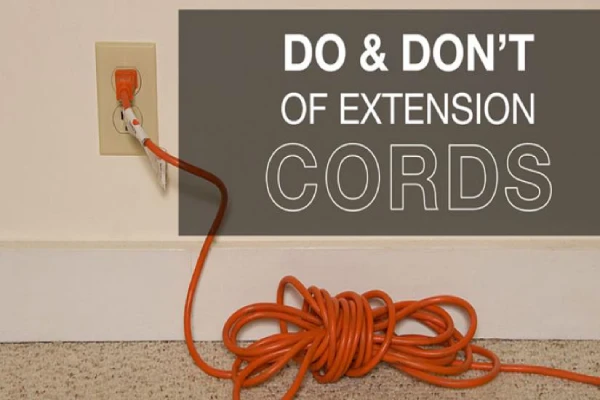
Rainbow Restoration highlights essential safety tips for using extension cords to prevent hazards and ensure proper usage.
|
Extension cords provide power for devices with cables that can’t reach any nearby electrical outlets. Choosing the right type of extension cord is important to ensure electrical safety and prevent home fires. Follow these dos and don’ts the next time you visit a hardware store to pick out extension cords.
DO Choose the Right Type of Extension Cord for Your Needs
Extension cords fall into three broad categories: occasional use, frequent use, and rugged use. To make sure you find the right types of extension cords for your needs, check the packaging or the cord itself for these designation letters:
- S indicates a general-use cord good for indoor applications.
- W indicates a cord designed for outdoor use. The biggest difference between indoor and outdoor extension cords is the insulation. Outdoor versions have bright orange rubber, plastic, or vinyl covers, while indoor cords are much less heavy-duty.
- J means the cord has standard 300-volt insulation. If you see no J designation, the cord is designed for heavier use with 600-volt insulation.
- P indicates a household extension cord with parallel wire construction.
- T means the cord jacket is made of vinyl thermoplastic.
- E means the cord jacket is made of thermoplastic elastomer rubber (TPE).
- O indicates an oil-resistant cord.
DO Buy Three-Prong Plug Extension Cords
Standard extension cords are available with either two or three prongs. One prong is “hot,” the second is “neutral,” and the third serves as a path to the ground wire. This third prong drastically reduces the risk of shock and electrical fires by giving power surges a safe place to dissipate.
Of course, you can only use three-prong extension cords with three-prong outlets. If your home has outdated electrical wiring, you may need to upgrade it before converting your outlets to newer three-prong versions designed for enhanced electrical safety.
DON’T Overload Your Extension Cords
Every cord has a maximum amperage rating or a limit of electrical current it can safely conduct. Check the device you plan to connect and choose an extension cord with an amp rating higher than the device. If you plan to connect multiple devices, add up all amp requirements to ensure you don’t overload the extension cord.
Tip: If the power requirement on a device is listed in watts, divide the wattage by 110 to convert the rating to amps.
If the cord you’re considering doesn’t give an amp rating, you can calculate its current capacity by its wire gauge. The lower the gauge, the higher the wire’s capacity. Follow these guidelines:
- A 16-gauge extension cord is for light-duty applications (holiday lights, portable fans, hedge trimmers, etc.).
- A 14-gauge cord is for medium-duty applications (lawnmowers, power drills, table saws, etc.).
- A 10- to 12-gauge cord is for heavy and extra heavy-duty applications (chainsaws, circular saws, shop vacs, air compressors, etc.).
In addition to amperage and gauge, you should also consider cord length when choosing the right type of extension cord. Longer cords create more electrical resistance and deliver less power to the connected device. It’s best to use a cord of the proper length to reduce power loss, especially if you’re using a device with a high amperage rating.
DON’T Plug Sensitive Electronics into Ordinary Extension Cords
Extension cords and surge protectors are not the same things. The purpose of a surge protector is to divert or block excess power by grounding it. Even minor surges could damage sensitive electronics, so plugging them into surge protectors (or extension cords with built-in surge protection) is vital.
For more home fire safety tips to prevent electrical fires, please contact Rainbow Restoration® today.
